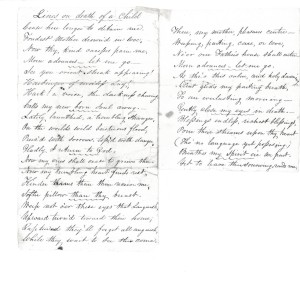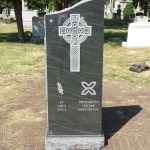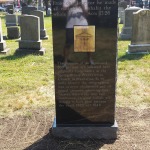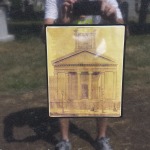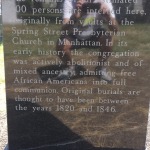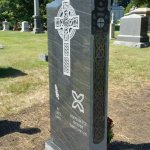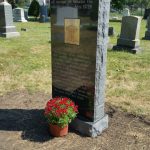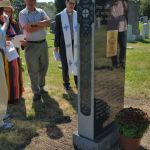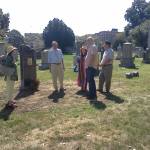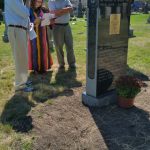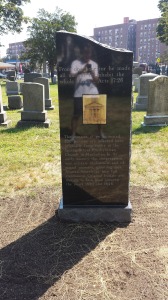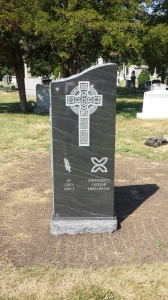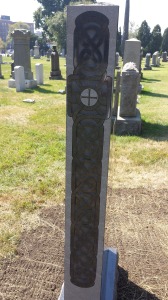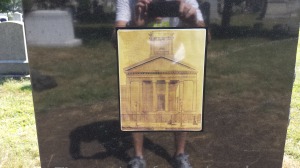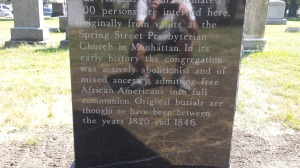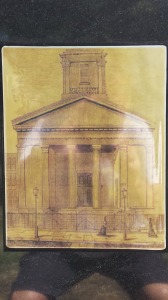Apologies if you’ve been trying to contact us via the form on this site! There was an error in the Contact Form plugin that has since been corrected.
If you are a descendent or researcher interested in learning more about the Spring Street Presbyterian Church, historical New York City, and our work, the form should be working now.
– K. Hicks
Category Archives: Uncategorized
The Bones Speak Film Trailer!
Have you seen the trailer yet for the documentary film being made about the Spring Street Presbyterian Church? The film, The Bones Speak, is a one hour documentary film about the history of the site and the race riots of 1834, as well as the archaeological work that has been done on the skeletal remains. The project was a recipient of the 2016 National Endowment for the Humanities Development Grant. You can see the trailer for the film-in-progress here:
Want to support this project, or learn more about it? Head to their website or Facebook page!
Congratulations to David Pultz and his entire team!
–Meredith A.B. Ellis
The Little Girl in the Poem
Hark! A voice, the darkness choosing,
Calls my new born soul away.
Lately, launched, a trembling stranger,
On the worlds wild boisterous flood,
Pierc’d with sorrows, tossed with danger,
Gladly I return to God.
–From Lines on the Death of a Child,
By a member of the Ludlow/Frey Family
In 2014, as I completed my dissertation The Children of Spring Street: The Remains of Childhood in a Nineteenth Century Abolitionist Congregation, I selected two stanzas from a poem, Lines on the Death of a Child, to open and close the story of the children of Spring Street. This poem was written about the death of Anna Frey, a child who died in 1830. I had found the poem among the Reverend Ludlow’s papers. The Reverend Ludlow was the third pastor of the Spring Street Presbyterian Church, between 1825 and 1837. His sister, Caroline, had married into the Frey family, and so I suspected that this little girl was a relative of his, either by marriage or more directly. The poem is from the perspective of the little girl, who “Gladly” goes to heaven after a brief time in this world (the full poem is transcribed at the end of this post, below). It is unclear who wrote the poem, but it was obviously written by a member of Anna Frey’s family. And so for me, the poem became a way to introduce the idea of the importance of children to their families, and the impact of their deaths on the lives of those who loved them. Despite doing some digging, I was unable to uncover any more about Anna Frey herself. So the poem became less about a specific girl and her specific life and death, and instead became a symbol to stand in for all of the children I would study.
It was with great surprise this past week, two years later, that I encountered Anna Frey’s name again. Over the summer of 2015, Dr. Shannon Novak and graduate student Cristina Watson worked through the New York City Death Records at the Family History Library of the Church of Latter-Day Saints in Salt Lake City, Utah. They transcribed the names, addresses, birth locations, dates of death, causes of death, and other information recorded about each person listed as buried at the Spring Street Presbyterian Church. This has given those of us working on the project a wealth of new information to work through. This week, I was working on sorting out the children from that list, organizing them by age, and noting anomalies or interesting bits of information to investigate. As I was working with the data, I noticed one entry had a young child born in Kinderhook, NJ. The Reverend Ludlow’s mother and sister as well as many of his friends lived there, so I stopped to read the rest of the entry. And it was with shock that I discovered that the entry was for one Ann Gertrude Frey, born in Kinderhook, NJ, living on Vandam Street when she died from convulsions at the age of 11 months and 7 days. Ann Frey, or Anna Frey, relative of the Reverend Ludlow, and the subject of the poem, was buried at the Spring Street Presbyterian Church. It was something that makes sense, of course, but considering she was related to him through his sister’s marriage and that that portion of the family was from New Jersey, I had never considered the possibility that she was buried at the church. And, even more stunning than the realization that she was buried at the church, was the second realization I had looking at that burial entry: I had likely held her remains in my hands. I had examined every child’s bone that had come out of the burial vaults, and if her remains were among those that had been preserved, then I had handled it.
This discovery moved me deeply. I got choked up when I realized what this all meant. The little girl in the poem had been a symbol for me. I knew she had been a real child, but I had no information about her specifically. But with this new information, she suddenly was very real—she has a middle name, an address, a cause of death, and a body that I likely touched. Bioarchaeology is many things: it is science, it is history, it is storytelling. But it is also a type of remembering, an erasing of silences created by the passing of time. Over the 186 years since Anna Frey’s body was buried, her memory had disappeared. No one who knew her during her brief life was still alive, and no descendants of her family’s lineage have yet to come forward. And so the only memory of her was a hand-written, grief-stricken poem in a box in a research library in Cooperstown, New York. But bioarchaeological projects like these allow us to remember people like Anna—to find again their stories, and share them. Every time now that I read this poem during a talk about this project, I can tell the audience to whom I am speaking a bit more about her life, where she lived, how she died. I can tell them that her skeleton was likely among those studied by us at Syracuse University and that I had likely held her remains in my hands. A whole new group of people can enter into remembering her, the little girl in the poem, Anna Frey.
This is not the first such discovery we have made working on this project, and it certainly will not be the last. As we continue to move forward combining the skeletal data and the archival records, we will have the opportunity to remember many more fascinating people, people who lived nearly 200 years ago, people whose remains we have studied and learned from. We are greatly moved and touched by each story, and we will continue to share these with you here. We hope you will continue to follow along.
–Meredith A.B. Ellis
Lines on the Death of a Child
Cease here longer to detain me.
Fondest Mother drown’d in love.
Now thy kind caresses pain me,
Morn advances–let me go.—
~~~~~
See you orient streak appearing!
Harbinger of endless day,!
Hark! a voice, the darkness choosing,
Calls my new born soul away.—
~~~~~
Lately lamented, a trembling stranger,
On the worlds wild boisterous flood,
Pierc’d with sorrows, tossed with danger,
Gladly I return to God.
~~~~~
Now my cries shall cease to grieve thee.
Now my trembling heart finds rest,
Kinder arms than thine receive me,
Softer pillow than thy breast.
~~~~~~
Weep not o’er these eyes that languish
Upward turn’d towards their home;
Raptured they’ll forget all anguish,
While they wait to see thee come.
~~~~~
These, my mother, pleasures centre—
Weeping, parting, care, or love,
Ne’er our Father’s house shall enter—
Morn advances – let me go.
~~~~~
As thr’o this calm, and holy dawning
Silent glides my parting breath,
To an everlasting morning~
Gently close my eyes in death.
~~~~~
Blessings endless, richest blessings,
Pour their streams upon thy heart
(Tho’ no language yet possessing)
Breathes my spirit ere we part.
And to leave thee sorrowing, rends me,
[End of document. Original at the New York State Historical Association Research Library at Cooperstown, New York, in the Frey Family Papers. Transcribed by Meredith A.B. Ellis and David and Elizabeth Pultz to look as close to the original as possible]
Descendants Speak: Mr. Thomas Hutchings
This post is the second in our series Descendants Speak, in which I interview descendants of those buried at the church. Mr. Hutchings’s story highlights how studying our pasts connects us to our presents–our own experiences, our own families, and our own interests. We have been fortunate to learn much from Mr. Hutchings about his family and the church from his research. If you think you might be related to an individual who was buried at Spring Street, please contact us. You can read the first entry in this series here. –Meredith A.B. Ellis
Why did you get involved with your family’s genealogy?
My Dad had always been interested in his genealogy, but never had time to pursue it. He used to occasionally remark, “We must have a castle somewhere in Scotland or England.” I learned our distant relations did, but we would have no claim.
His younger sister, Janet (my Aunt), lived in Southern California her entire life. Many of my family and cousins had removed themselves from Southern California and family visits with her were scarce. Living a mere 250 miles away, I became her closest relative. As she was aging, I would visit her on a monthly or bi-monthly basis. We would spend the day together, most of which was taken in telling family stories from the past and reviewing old photographs. It was while visiting with her that I decided to begin the family search. That was around 1985. I’ve been searching since.
With some early stories to unearth, I was able to confirm or change some substantial facts of some of her stories with her. She was happy that the stories could be discovered so easily. This was before the internet. At the time, I had to rely on the LDS catalogues and visits to the National Archives.
What have you learned about your family, particularly about Samuel and Lois Hutchings?
I have learned a lot about Samuel and Lois. Samuel was born into a family of four boys and two girls. He was born in 1761 in Connecticut Farms, NJ. Learning about Samuel helped me learn more about the Revolutionary War. I had read some accounts in several genealogical books that Samuel was held a prisoner by the British. Searching the records, I could not find anything about his being a prisoner. It was a recent search a couple of years ago that bore out that fact. In his writing about the family, as he knew it, Reverend Samuel Hutchings, Samuel’s son, wrote a 27 page typescript. In it he wrote that he had learned as a young boy that his father, Samuel, had gone into the (New York) harbor aboard a small fishing smack (a small boat for fishing along the Atlantic coastline) and had fired into a British frigate and was taken prisoner. He was only 15 years old at the time. His older brother Jonathon, who was a Tory, brought him provisions. Samuel tried escaping with others, but was caught. He was eventually released. I discovered that his father, Jacob, took the family back to Elizabeth, NJ, for the duration of the war.
What favorite stories have you learned about your ancestors during this time period?
I learned that the Hutchings were quite diverse in their politics. Samuel was very religious and patriotic, as borne out by the story of his being taken prisoner by the British. There are many interesting stories I have learned and have pieced together, but one stands out. It is about the life of Theodore C. Hutchings. Theodore was the sixth child and third oldest son of Stephen B. Hutchings, Samuel and Lois’s fifth child and third oldest son. Theodore was Samuel and Lois’s grandson. Theodore was 5 years old at the time of Samuel’s death. He never knew his grandmother, Lois, who died 6 months earlier.
Theodore was an eclectic person. There is some evidence I am still trying to uncover that he was an actor at a very young age. An obscure article in New York City around the early 1830s tells the story of a young Teddy Hutchings, an aspiring actor, who plays New York City and had additional experience in London (I read the article, but failed to save it). This must have been the same Theodore, because in the 1860 Census in Ashland, Ohio, he is listed as an actor.
Theodore’s experiences were many. In January 1848, gold was discovered in California. On January 15, 1849, Theodore and William Le Blanc, his brother-in-law and husband of Helen Louise Hutchings were listed as passengers aboard the bark, Croton, and headed for the gold fields of California. They sailed around the tip of South America and landed in San Francisco on June 4, 1849. The day before landing, each of the gold miners signed the “Croton Compact,” agreeing to meet in New York City at the Astor House on the fifth anniversary of landing in San Francisco. They were all to have dinner at 7 PM on the 4th of June. It is unknown if any dinner took place.
According to Wallace Van Cortland Auser, “On board the bark Croton a bunch of the boys were whooping it up at the prospect of landing at San Francisco the next day and quickly striking it rich in the gold fields.” I wonder how Theodore and William fared. I do know that Theodore was still living in Sierra, California, in the heart of “Gold Country” in 1852, according to the 1852 California Census.
By 1855, Theodore was back in New York City and in 1857 was married to Frances A. Fenner, the daughter of a mariner. Had he met Frances through a fellow mariner? Frances was the same age as Theodore, and earlier at the age of 17 in 1843, Theodore was listed on the U.S. Seaman’s Certificate of Protection as a certified seaman who was a U.S. citizen, and protected against impressment by the British fleet.
By 1859, Theodore and Frances were in Cincinnati, Ohio, where their first son, Theodore C. Hutchings was born in December of that year. Seven months later, they are in Ashland, Ohio, and listed in the 1860 Census.
On May 14, 1860, Francis “Frank” Thomas Hutchings was born in Columbus, Ohio.
In April 1861, the War Between the States broke out: The Civil War. Theodore enlisted as a private in the 34th Ohio Volunteer Infantry, and was later promoted to Sergeant. His enlistment documents describes him as “Eyes, brown; Hair, black; Complexion, dark; Height, 5′ 5 3/4 inches.” He enlisted on July 25, 1861, at Camp Lucas, Clermont County, Ohio. His unit served primarily in West Virginia skirmishes and battles.
On December 22, 1864, Theodore’s regiment boarded trains for Webster, Virginia and then encamped at Beverly, Virginia on December 28. On January 11, 1865, a Confederate force attacked Beverly, surprising the Union garrison and capturing most of the Northern soldiers. The few members of the 34th that did escape retreated to Philippi, West Virginia. The 34th Ohio Volunteer Infantry Regiment was disbanded and merged with the 36th OVI. During the War, Theodore’s unit had seen 10 officers and 120 men killed, and another 130 men dead from disease or accidents.
Reviewing Theodore’s military records, he needed to take leave from the military a year after joining. He received notice his wife had died. He writes to his the Adjutant of the 34th OVI.
“Flat Top Tannery, VA., July 27, 1862
Sir,
I have the honor to apply for a furlough for the following reasons.
Having received a dispatch announcing my wife’s death, and leaving two helpless children, one nearly three and the other one years old, among entire strangers, it is my wish to place them in a position should any unforeseen accident happen to me. That they would be well taken care of, and not left altogether to the charities of the cold world.
//s// Theodore C. Hutchings
Sergt. Co “F. 34th O.V.I.
To E.T. Charles, Jr.
Adjt, 345h O.V.I.”
Theodore was gone for about a month, having placed Theodore Jr, and Frank in the care of friends, Eugene Cone and his family, in Westbrook, CT. Mr. Cone is listed in the 1870 US Census as a Ship Carpenter.
I can personally feel the emotions that Theodore felt, being a combat veteran myself, and sharing similar experiences as Theodore. At the end of the Civil War, he was mustered out of the service on 27 July 1865 from Wheeling, W.VA. Within 88 days, on October 23, 1865, Theodore was dead. On his death certificate, signed in Manchester, NH, Theodore had died at the age of 40 of typhoid.
Typhoid was also known at the time as “camp fever.” It was believed that Theodore had contracted typhoid during his military encampment in West Virginia. This was, at least, the position Frank took when applying for Veteran’s benefits years later. He was denied.
Theodore was buried in the Marble Cemetery, New York City, on October 27, 1865, in the vault of family friends, the Thayers. In May 12, 1870, Theodore was reinterred and laid to rest in the Hutchings’ family plot of the Oakhill Cemetery, in Nyack, NY.
His grave is marked by the typical tombstone. I am applying to the Department of Veterans Affairs and working with staff at Oak Hill to provide a Veteran Grave Marker for Theodore.
An odd postscript to Theodore. After years of searching and obtaining personal records, and searching church records, I could never find Theodore’s middle name referenced at all. He is simple Theodore C. Hutchings. Like his father, Stephen B. Hutchings, who never recorded his middle name, I learned through a distant cousin whose father was named Stephen Brown Hutchings. She asked him, when he was still alive, how he came by his name. He replied, “It’s an old family name.”
How did you find out about the Spring Street Archaeology Project?
While searching for records regarding the Spring Street Presbyterian Church and Samuel’s involvement, I saw an article in a Greenwich newspaper about the project.
What did it mean for you to attend the memorial for the Spring Street congregation?
Attending the memorial for congregation was very touching and meaningful. It gave me a much better sense of belonging to my heritage.
Why does this archaeology and history project matter to you?
It matters to me because it puts an additional face to the character of my family. Learning about the health concerns, issues, and dangers, along with a generalized lifestyle of the people of the area, diet, habits, and illnesses, makes me more aware of how Samuel and Lois coped.
Why is important to you, as a descendant, to be a part of a project like this?
As a descendant of Samuel and Lois, being a part of this project allows me to remain connected to ongoing research into the Spring Street Presbyterian Church, and it opens up new avenues of research for me into my distant family.
“New” Website!
Thank you for your patience as we’ve transferred our hosting to the Syracuse University servers.
Though we’ve transferred our hosting, our old domain, www.springstreetarchaeologyproject.com, will still direct you to our homepage.
We would like to thank everyone at Syracuse University Information Technology Services who helped with this transition, taking the time to update and migrate the site.
Headstone Design
Below is a brief interview with David Pultz about the design of the headstone memorial at Green-wood Cemetery in Brooklyn, NY. A few images are included; more can be seen in an earlier post or on our Facebook page–Meredith A.B. Ellis
Tell us a little about the process of coming up with the design for the headstone. What inspired you?
The inspiration came from the courage of the people at the Spring Street Church who stood against slavery and accepted people of different walks of life and ancestry into the congregation. I wanted to present text and symbolic imagery that represented that story. The ideas of how to arrange that, and in what media to use, evolved slowly as I thought about it over a period of months. I hasten to add that I made initial sketches and discussed ideas with my wife Elizabeth. Later in the process I also got valuable guidance from the memorial company in Brooklyn that handled the manufacture and delivery of the marker. Cost was a consideration as well. We had spent a fair amount for the reburial and subsequent memorial service. The remainder of our budget all went to the stone.
What do the different elements on the headstone mean or represent?
The stone is a vertical black granite slab that stands a little over five feet with the base. The top is at a somewhat diagonal slant. To me, the overall shape suggests the ancient standing stones found in the Orkney Islands of Scotland. That represents a kind of timelessness of human spiritual expression, at least in my mind. The granite is called “black mist” and is mined in Pennsylvania.
On the front face at the top is a quote from the book of Acts, “From one ancestor he created all nations to inhabit the whole earth…” In biblical terms, this stated what seemed to me was the prime belief animating the Spring Street Church’s opposition to slavery . One could argue that this also represented the highest ideals of the entire abolitionist movement.
In the middle is a 19th century drawing of the church on a rectangular enameled steel plate, recessed into the granite. Below that is text telling the story of the church in brief summary. I got valuable help from Shannon Novak in shaping the information.
I didn’t want the reverse side to be blank, so I have a Celtic cross taking up at least half of the space. This is of course a Christian symbol, but also refers to the roots of the Presbyterian denomination in Scotland.
The two images below that are West African and come from Ghana and the Ivory Coast. They are part of a series of symbols used in that part of Africa called Adinkra. I chose the branch with leaves, which means “By God’s Grace” and the abstracted icon meaning “Independence, Freedom, Emancipation.” Both have reference to those of African ancestry buried there, but also in a wider sense to the whole congregation’s struggles during the early part of its history.
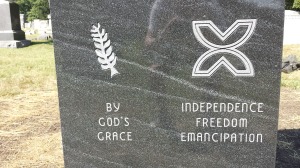
What is the significance of Green-wood Cemetery as the final resting place for the Spring Street congregants?
Green-Wood is one of the most historic and elaborately varied places of monuments and memorials in the entire country. It is kind of an over-the-top sculpture park begun in the mid-19th century where many famous people are buried. It’s also the area where Washington’s continental troops fought the Battle of Brooklyn in August 1776. A place that rich in history seemed appropriate to my committee as a reburial spot. Green-Wood is also a very expensive place. We were fortunate to find that the Presbytery of New York owns several graves there, which was highly convenient.
How do you hope that visitors feel when they see the headstone? What message would you like them to take away from the visit?
I would hope that they feel a sense of importance to the story connected with the people buried there, and that it represents the efforts of one small group that stood for human rights.
Additional images from the dedication ceremony:
Reburial Update
In 2014, the skeletal remains from the Spring Street Presbyterian Church were reburied in Green-wood Cemetery. In September 2015, a headstone was installed commemorating. David Pultz has shared a few photographs he took of the headstone; it beautifully commemorates the spirit of the congregants of this remarkable church. –Meredith A.B. Ellis
Descendants Speak: Mr. Frank Nattrass
This post is the first in our series Descendants Speak, in which I interview descendants of those buried at the church. Mr. Nattrass’s interview is particularly moving, as he talks about what it means to him to learn about the life of his great great grandmother who is buried at the church. If you think you might be related to an individual who was buried at Spring Street, please contact us. –Meredith A.B. Ellis
Mr. Nattrass, can you tell us a little bit about yourself?
I was born Frank Peter Nattrass on November 19, 1932 in Brooklyn, Kings, New York. The Nattrass family had been living in the area since my gg grandfather John Nattrass and his family moved there from Dutchess County, NY in about 1828. John is listed in the directory as a grocer at 204 Varick corner Hamersley from 1828-1837. In the 1830 Census the family is enumerated on Hamersley. My gg grandmother Sarah (Sally) died January 19, 1836 and was buried at the Spring Street Presbyterian Church. Since I suspect that the business was probably a Ma & Pa type grocery business he found that after her untimely demise that he couldn’t run the business without her, and the next reference I found for him is in the 1850 Census where he is living with one of his sons who is in the business of manufacturing and repairing stoves in Brooklyn. My gg grandfather John died on April 30, 1851, and was buried in Green-Wood Cemetery in Brooklyn.
Shortly after my birth, my parents moved to New Rochelle, Westchester, NY, which is where my Nattrass grandparents had moved previously. My father was a music publisher and would commute to NYC to his office at 145 W. 45th St.
I graduated from New Rochelle High School in 1951 and went on to The Art Institute of Chicago Goodman Memorial Theater on a scholarship. From there I served 2 yrs. in the United States Army during the Korean War. I have lived in the Los Angeles area and the San Francisco area of California, Minneapolis area of Minnesota and now the Phoenix area of Arizona. I have had a colorful and wonderful life so far and am happily married to my wife Sherrie who you met.
Why did you get involved with your family’s genealogy?
I have been interested since childhood. My mother told us stories about our grandfathers both of whom had died before I was 3 yrs old. In 1973 I became a member of the Church of Jesus Christ of Latter-Day Saints and began doing research in earnest. In the Church we believe that families can be sealed together for eternity. So as members of the Church we search out their names and perform sealing ordinances for them in our Temples.
What have you learned about your family, particularly about your relatives buried at the Spring Street Presbyterian Church?
Sarah (Sally) Nattrass was born Sarah Nelson on 9 Aug 1777 in Poughkeepsie, Dutchess, New York to Thomas Nelson and Sarah Wright. Sarah is the only ancestor who was buried at the Spring Street Presbyterian Church. I have a good deal of family history on the Nelson line with that lineage traced back to the 1620’s.
What favorite stories have you learned about your ancestors during this time period?
Recently I was very interested to learn that the Spring Street Church was an abolitionist congregation and that the Sunday School and other services were multiracial. This information gives me new feelings of pride for my heritage knowing that they stood up for what was right in spite of the political correctness and social stigma of the time.
How did you find out about the Spring Street Archaeology Project?
I knew where the other members of my family were buried but I had no idea about the location of the Spring Street Church. In my mind, I pictured a quaint old church with a graveyard adjoining. I decided to find the address of the church so I did and online search and got the surprise of my life!
What did it mean for you to attend the memorial for the Spring Street congregation?
It was an honor to be in attendance and to celebrate the lives of those brave people who believed that all men are created equal in the eyes of God.
Why does this archaeology and history project matter to you?
It is a search for truth. Uncovering truth is a way to understand our past and gives us a sense of our heritage. For me especially, I received a great feeling of pride in my ancestors who risked everything to follow their conscience and stand firm on their beliefs regardless of the type of persecution they must have endured.
Why is important to you, as a descendant, to be a part of a project like this?
I have learned that my direct ancestors turned out to be heroes. It gives me an incentive to be a better citizen and a better person.

Frank Nattrass pictured with students and Dr. Shannon Novak at the Spring Street Memorial Service Reception, October 2014.
Article in Forbes
Check out this article in Forbes about our research!
Children in Manhattan Got Scurvy and Rickets, 19th Century Skeletons Reveal
An Interview with David Pultz: The Spring Street Story: A Documentary Film
I recently had a chance to interview David Pultz. Here is our conversation about his work creating The Spring Street Story: A Documentary Film. –Meredith A.B. Ellis
Tell us a little about your involvement with the Spring Street project. How did you get involved?
I was asked by the Presbytery of New York back in January 2007, along with a couple of others from First Presbyterian Church to visit a construction site where some burial vaults with human remains were found that were part of a former Presbyterian Church. The Presbytery had been contacted by the developer of the site, asking if they would take custody of the remains for eventual reburial. I believe First Presbyterian was subsequently contacted with the idea that perhaps the remains could be re-interred in its vaults. I was then asked if I would become part of the Presbytery’s Spring Street Committee, which I did. I’m assuming I was drawn into this project because of my position as Archivist at First Presbyterian and general interest in history.
(Read more about David Pultz’s involvement here: Eulogy by David Pultz)
Where did the idea come from to do a documentary film about the site and its history?
It generally evolved in my mind as I began to learn more about the history of the Spring Street Church, and in particular its abolitionist pastors and the fact that it practiced what it preached by accepting free African Americans into full membership.

